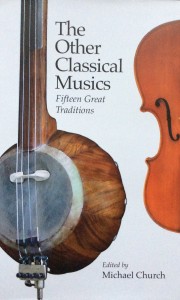
Auf ein solches Buch habe ich lange gewartet: weg vom Fokus klassischer Musik immer nur auf den Westen mit Bach, Bartók, Beethoven und Britten – hin zu einem gleichberechtigtem Blick auf klassische Musik aller Kulturräume!
In seiner wunderbar kompakten und nuancierten Einleitung (wenigstens die sollte man lesen, wenn schon vielleicht nicht das gesamte Buch!) nähert sich Church einer Definition von klassischer Musik: „According to our rule-of-thumb, a classical music will have evolved in a political-economic environment with built-in continuity (…) where a wealthy class of connoisseurs has stimulated ist creation by a quasi priesthood of professionals; it will have enjoyed high social esteem. It will also have had the time and space to develop rules of composition and performance, and to allow the evolution of a canon of works, or forms; indeed, the concept of a canon, validated by a system of music theory, is a defining feature of all classical music.“
Das eröffnet ein weites Feld. Und so gibt es Kapitel über die klassische Musik Japans, Chinas, Indiens, Andalusiens, Malis… Die europäische klassische Musik wird in Kapitel 10 behandelt als eine unter den anderen klassischen Musiken. Auch der nordamerikanische Jazz erhält nachvollziehbar den „klassischen“ Status.
Jedes Kapitel beginnt mit einer typischen Situation, einem typischen Setting der jeweiligen klassischen Musik. Das soziale Umfeld und die geschichtliche Entwicklung werden beschrieben; Modi, Tonleitern und musiktheoretische Grundlagen erläutert; Instrumente, Formate und ästhetische Ziele dargestellt. Das Buch ist sehr gut lesbar und verständlich, auch wenn sich die musiktheoretischen Abschnitte trotz bestem Bemühen der Autoren wahrscheinlich nicht jedem Leser (und mir) erschließen.
Das Buch ist augenöffnend, faszinierend, lebendig, vieldimensional. Auch für die Ohren ist etwas dabei, wenn man den CD-Empfehlungen folgt.
Es stimmt aber auch etwas melancholisch: „Today the existential threat to the world’s musics is compared to the threat hanging over ist spoken languages, which are dying out so fast that most of the existing six thousand will have gone by the end of this century. And there is indeed a parallel: a music may not be a language, but it will have a grammar, and like spoken languages (…) it needs ist own eco-system to thrive.“
Gelesen habe ich die Erstauflage von 2015. Angeregt wurde ich von einer Rezension im Economist mit dem Fazit: „There is a treasure trove of underappreciated music out there; this book will convince many to explore it.“